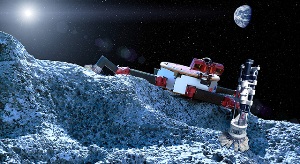Jul 11 2014
From hopping/tumbling robots to gecko-inspired adhesives, a variety of technologies have been chosen by NASA for flight on commercial reusable launch vehicles and a commercial parabolic aircraft. The selections were made through NASA's Flight Opportunities Program.
The program gives these 13 space technology payloads, including four from NASA's Jet Propulsion Laboratory, Pasadena, California, a chance to be tested before they are used in the harsh environment of space.
 This artist's concept shows a robot with legs that have microspine grippers, which could potentially explore a rocky surface, such as an asteroid, in microgravity. Image credit: NASA/JPL-Caltech
This artist's concept shows a robot with legs that have microspine grippers, which could potentially explore a rocky surface, such as an asteroid, in microgravity. Image credit: NASA/JPL-Caltech
Including this latest selection, there have been 138 technologies selected for test flights facilitated by the Flight Opportunities Program of NASA's Space Technology Mission Directorate.
Parabolic aircraft flights will allow 11 of the new payloads to experience brief periods of weightlessness. The other two projects will fly on suborbital reusable launch vehicle test flights. The flights are expected to take place in 2014 and 2015.
The selected proposals requested flights on Zero-G Corporation's Boeing 727 parabolic flight aircraft, UP Aerospace's Space-Loft rocket and Masten Space Systems' Xombie vertical takeoff/vertical landing rocket.
Three of the JPL-led payloads will fly on the parabolic aircraft and one will go up on the suborbital reusable launch vehicle.
The payloads selected for parabolic aircraft flights are:
From JPL:
- "Validating Microgravity Mobility Models for Hopping/Tumbling Robots," Principal Investigator (PI) Issa Nesnas
- "Microgravity Rock Coring Drill Using Microspines" and "Gecko Adhesive Grippers in Microgravity," PI Aaron Parness
From other institutions:
- "Reduced Gravity Flight Demo of SPHERES Universal Docking Ports" and "Reduced Gravity Flight Demonstration of SPHERES INSPECT," PI Alvar Saenz Otero of Massachusetts Institute of Technology in Cambridge, Massachusetts
- "Reinventing the Wheel: Parabolic Flight Validation of Reaction Spheres," PI Alvin Yew of NASA¹s Goddard Space Flight Center in Greenbelt, Maryland
- "Enhanced Dynamic Load Sensors for ISS Operational Feasibility for Advanced Resistive Exercise Device," PI Christopher Krebs of Aurora Flight Sciences Corp. in Manassas, Virginia
- "Effects of Microgravity on Intracranial Pressure," PI Benjamin Levine of University of Texas Southwestern Medical Center in Dallas
- "Noninvasive Hemodynamic Monitoring in Microgravity Phase II (Arterial Stiffness)," PI Gregory Kovacs of Stanford University in Stanford, California
- "Payloads Separation Performance of a 6U CubeSat Canisterized Satellite Dispenser," PI Hans-Peter Dumm of the United States Air Force Space Vehicles Directorate in Albuquerque, New Mexico
- "Dragon V2 Propellant Management Device Microgravity Testing," PI Robin Titus of Space Exploration Technologies Corp., (SpaceX) in Hawthorne, California
The payloads selected for flight on a suborbital reusable launch vehicle are:
From JPL:
- "Fuel Optimal and Accurate Landing Systems Test Flights," PI Andrew Johnson
From Purdue University:
- "Zero-gravity Green Propellant Management Technology," PI Steven Collicott of Purdue University in Lafayette, Indiana
NASA manages the Flight Opportunities manifest, matching payloads with flights, and will pay for payload integration and the flight costs for the selected payloads. No funds are provided for the development of these payloads.
The Flight Opportunities Program, part of NASA's Space Technology Mission Directorate, is managed at NASA's Armstrong Flight Research Center at Edwards, California. NASA's Ames Research Center at Moffett Field, California, manages the solicitation and selection of technologies to be tested and demonstrated on commercial flight vehicles.
For more information on the Flight Opportunities program, visit: http://flightopportunities.nasa.gov